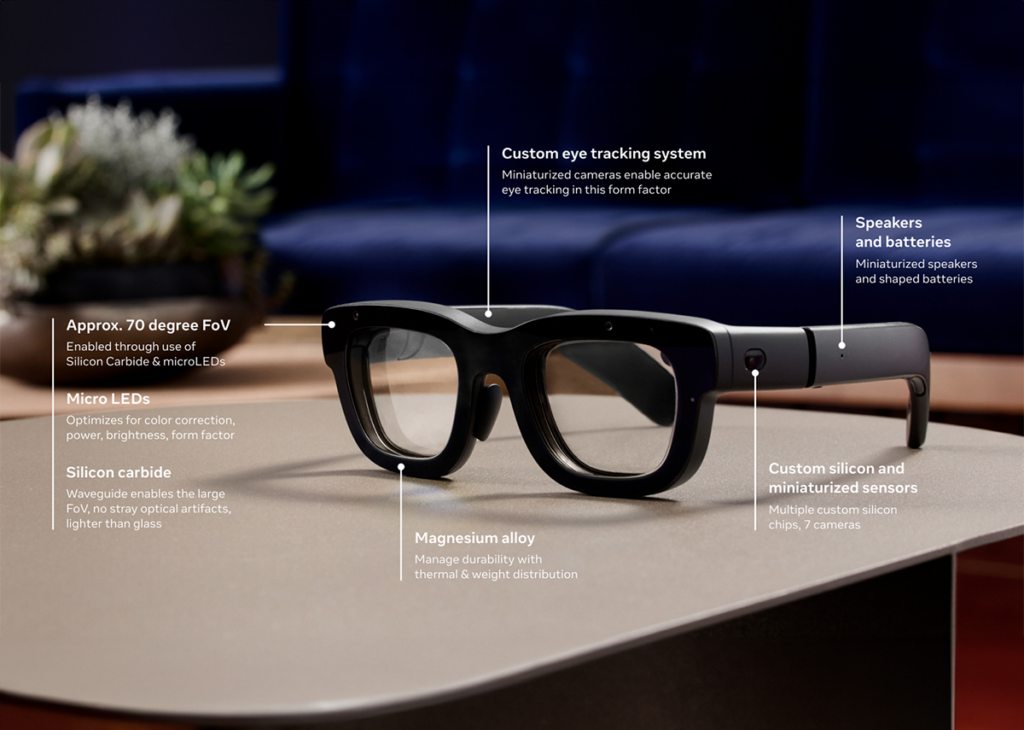Meta has unveiled an innovative multi-layer lens system designed specifically for their upcoming Orion AR smartglasses. This development, revealed in a recently published patent, could potentially revolutionize how AR displays are manufactured while substantially reducing production costs and improving optical performance.
The new technology represents a departure from conventional lens manufacturing processes, introducing a sophisticated multi-layer approach that addresses several long-standing challenges in AR optics. At the heart of this innovation is a unique lens construction method that combines multiple layers with precise temperature control and positioning, resulting in superior optical properties while maintaining manufacturing efficiency.
Traditional AR lens manufacturing has been limited by high-pressure requirements and stress-induced optical distortions, known as birefringence. Meta’s new approach significantly reduces these limitations by utilizing a multi-stage manufacturing process that carefully manages material stress and temperature throughout production. This novel method allows for the creation of lenses with unprecedented precision and consistency.
One of the most striking advantages of Meta’s new technology is its potential impact on manufacturing scalability. The patent documentation reveals that the multi-layer approach could more than double the conventional cavitation capacity—from four to eight or more—representing a significant advancement in production efficiency. This improvement could dramatically reduce manufacturing costs while maintaining or even enhancing the optical quality of the final product.

The technical implementation of the multi-layer system is particularly noteworthy. According to the patent, the process begins with the creation of a primary lens layer, which undergoes careful monitoring until it reaches a specific threshold temperature. This initial layer is then precisely positioned for the addition of subsequent layers, either above or below the primary layer, resulting in a unified optical element. The process is carefully controlled by a sophisticated system of memory and processors that coordinate the entire manufacturing sequence.
What makes this approach particularly innovative is the careful consideration given to layer thickness ratios. The primary layer typically comprises 60-80% of the total lens thickness, while secondary layers make up the remaining 20-40%. These proportions are not arbitrary but are carefully calculated based on various factors, including material properties and overall lens geometry, to achieve optimal optical performance.
The technology is specifically designed for implementation in Meta’s Orion AR glasses, which aim to seamlessly blend digital content with the user’s view of the real world. The glasses’ design incorporates these multi-layer lenses within a sophisticated waveguide system, housed in what appears to be a conventional eyeglass frame. This integration allows users to view both their natural environment and computer-generated content through the same optical pathway.
The manufacturing process itself represents a significant advancement in AR optics production. The patent describes a sophisticated production line featuring multiple stations for molding, cooling, and assembly. These stations are interconnected and controlled by a central server that coordinates the entire manufacturing process, ensuring precise timing and conditions for each stage of lens production.
The implications of this technology extend beyond just manufacturing efficiency. The reduced stress on the optical elements during production could lead to better durability and longer-lasting AR devices. Additionally, the ability to precisely control the properties of each layer opens up new possibilities for optical design, potentially enabling better field of view, reduced distortion, and improved visual clarity in AR applications.
This development comes at a crucial time in the AR industry, as major technology companies race to create consumer-friendly AR glasses that can deliver compelling experiences while maintaining a form factor similar to traditional eyewear. Meta’s multi-layer lens technology could provide a significant competitive advantage in this rapidly evolving market.
The patent also hints at the possibility of creating lenses with more than two layers, suggesting that future iterations of the technology could enable even more sophisticated optical designs. This flexibility in manufacturing could prove crucial as AR technology continues to evolve and demand more complex optical solutions.
As the AR industry continues to mature, manufacturing innovations like Meta’s multi-layer lens technology will play a crucial role in making high-quality AR devices more accessible to consumers. By solving key manufacturing challenges while potentially reducing costs, Meta’s new technology could help accelerate the adoption of AR smartglasses and bring us closer to a future where digital and physical realities seamlessly coexist.
















Add Comment